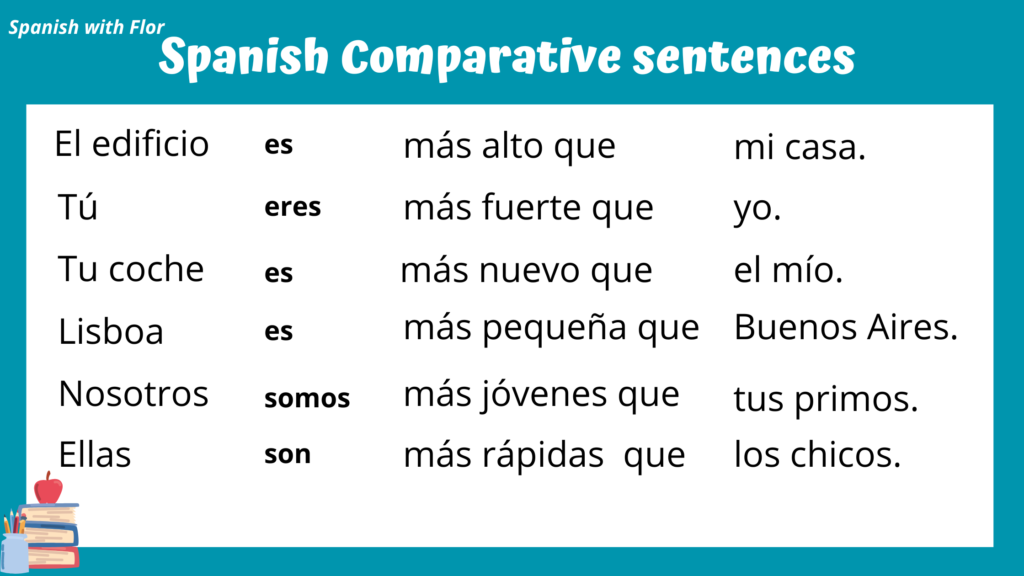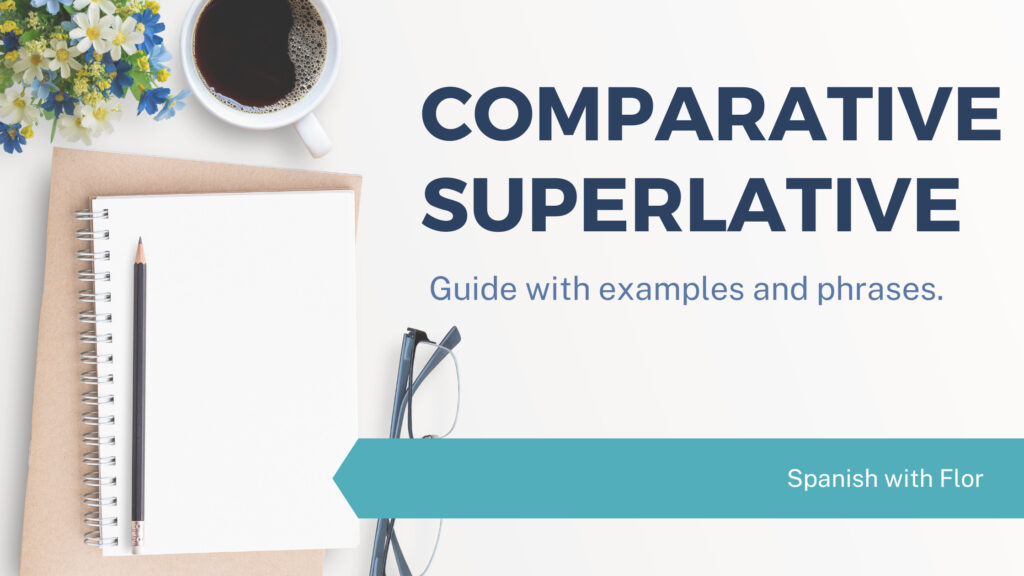Comparatives in Spanish are structures that allow people to compare and contrast someone or something’s characteristics against others. They are used to express that one thing is more or less than another. Comparatives are formed by adding “más” (more) or “menos” (less) before an adjective or adverb, followed by “que” (than).
Here are some examples:
- María es más alta que Juan. (María is taller than Juan.)
- El coche es menos rápido que el avión. (The car is less fast than the plane.)
- Mi casa es más grande que la tuya. (My house is bigger than yours.)

When comparing nouns, “más” or “menos” can be used before the noun, followed by “que“.
- Tengo más libros que tú. (I have more books than you.)
- Hay menos personas en la fiesta que el año pasado. (There are fewer people at the party than last year.)
What are Superlatives in Spanish?
Superlatives in Spanish are used to express the highest or lowest degree of a quality, and they are formed by adding a definite article (el, la, los, las), the noun and the word “más” before the adjective.
Here are some examples:
- El edificio más alto de la ciudad. (The tallest building in the city.)
- La película más aburrida que he visto. (The most boring movie I’ve seen.)
- La comida más deliciosa del mundo. (The most delicious food in the world.)

To make it easier to understand, here you have a table with the comparative and superlative adjetives in Spanish:
| Adjetivo | Comparativo | Superlativo |
|---|---|---|
| Grande (big) | Más grande que | El /La más grande |
| Pequeño (small) | Más pequeño que | El /La más pequeño/-a |
| Rápido (fast) | Más rápido que | El /La más rápido/-a |
| Lento (slow) | Más lento que | El /La más lento/ -a |
| Fuerte (strong) | Más fuerte que | El /La más fuerte |
| Débil (weak) | Más débil que | El /La más débil |
| Alto (tall) | Más alto que | El /La más alto/ -a |
| Bajo (short) | Más bajo que | El /La más bajo/-a |
| Rico (rich) | Más rico que | El /La más rico/-a |
| Pobre (poor) | Más pobre que | El /La más pobre |
| Joven (young) | Más joven que | El /La más joven |
| Viejo (old) | Más viejo que | El /La más viejo/-a |
| Inteligente (smart) | Más inteligente que | El /La más inteligente |
| Tonto (silly) | Más tonto que | El /La más tonto/-a |
| Bonito (pretty) | Más bonito que | El /La más bonito/-a |
| Feo (ugly) | Más feo que | El /La más feo/-a |
| Interesante (interesting) | Más interesante que | El /La más interesante |
| Aburrido (boring) | Más aburrido que | El /La más aburrido/-a |
| Feliz (happy) | Más feliz que | El /La más feliz |
| Triste (sad) | Más triste que | El /La más triste |
| Bueno (good) | Mejor | El /La mejor |
| Malo (bad) | Peor | El /La Peor |
| Grande (old in age) | Mayor | El /La mayor |
| Pequeño (young in age) | Menor | El /La menor |
How to make Comparative Sentences
To form comparatives in Spanish, you need to use certain elements. Here are some examples:
- Noun phrase + verb + más + adjective + que: El coche es más rápido que la bicicleta. (The car is faster than the bicycle.)
- verb + más + adverb + que: El niño corre más rápidamente que la niña. (The boy runs more quickly than the girl.)
- Noun + verb indicating quantity + más + noun + que: El libro tiene más páginas que la revista. (The book has more pages than the magazine.)
Notice that in all of the examples above, we used the word “más” which means “more” in English. This is the most common way to form comparatives in Spanish.
Comparative adjectives are used to compare two things. Here are some examples of how to form comparative adjectives in Spanish:
- Tu casa es más grande que la mía. (Your house is bigger than mine.)
- Mi hermano es más alto que yo. (My brother is taller than me.)
- Este libro es más interesante que ese. (This book is more interesting than that one.)
Spanish Comparative Sentences Practice
How to make Superlative Sentences
To form superlatives in Spanish, you need to use the definite article “el,” “la,” “los,” or “las,” depending on the gender and number of the noun you are comparing. Here are some examples:
- El coche más rápido es el que tiene el motor más potente. (The fastest car is the one with the most powerful engine.)
- La niña más alta de la clase es Ana. (Ana is the tallest girl in the class.)
- Los libros más interesantes son los que hablan sobre historia. (The most interesting books are the ones that talk about history.)
Notice that in all of the examples above, we used the definite article “el,” “la,” “los,” or “las” before “más” to form superlatives. This is the most common way to form superlatives in Spanish.
Superlative adjectives are used to compare three or more things. Here are some examples of how to form superlative adjectives in Spanish:
- Mi perro es el más lindo del parque. (My dog is the cutest in the park.)
- Este es el libro más interesante que he leído. (This is the most interesting book I have read.)
- La comida en ese restaurante es la mejor de la ciudad. (The food at that restaurant is the best in the city.)
- “Ese es el coche más caro que he visto.” (That’s the most expensive car I’ve seen.)
- “Mi hermana es la más inteligente de la familia.” (My sister is the smartest in the family.)
- “Este es el mejor restaurante de la ciudad.” (This is the best restaurant in the city.)
Irregular Comparatives and Superlatives
Some adjectives have irregular comparative and superlative forms. Here are some examples:
- Bueno: mejor (better), el/la/los/las mejor(es) (the best)
- Malo: peor (worse), el/la/los/las peor(es) (the worst)
- Grande: mayor (older), el/la/los/las mayor(es) (the oldest)
- Pequeño: menor (younger), el/la/los/las menor(es) (the youngest)
Viejo (Old)
The comparative form of “viejo” is “mayor” and the superlative form is “el/la mayor”. For example:
- Mi abuela es mayor que mi abuelo. (My grandmother is older than my grandfather.)
- Él es el hijo mayor de la familia. (He is the oldest son in the family.)
When comparing ages, in Spanish we use the comparative adjectives “mayor” and “menor”. For example:
- Juan Carlos es mayor que Marta. (Juan Carlos is older than Marta)
- Francisco es su hermano menor. (Francisco is her/his younger brother)
Remember that irregular comparatives and superlatives do not follow the same pattern as regular comparatives and superlatives.
Malo (Bad)
The comparative form of “malo” is “peor” and the superlative form is “el peor”. For example:
- Ese restaurante es peor que el otro. (That restaurant is worse than the other one.)
- Este es el peor día de mi vida. (This is the worst day of my life.)
Spanish Superlative Sentences Practice
Gender and Number in Comparative and Superlative
When forming comparatives and superlatives in Spanish, it is important to consider the gender and number of the nouns being compared. This is because Spanish is a language that distinguishes between masculine and feminine, as well as singular and plural.
For adjectives, the comparative and superlative forms must agree in gender and number with the noun they are modifying. For example, if you want to say “Juan is taller than Maria”, you would say “Juan es más alto que Maria” because Juan is masculine, or “María es más alta que Juan” because Maria is feminine.
When using the verb “ser” (to be) to make comparisons, the gender and number of the subject must also be taken into account. For example, “La casa es más grande que el apartamento” (The house is bigger than the apartment) or “Los coches son más rápidos que las bicicletas” (The cars are faster than the bicycles).

Hi there! I’m Flor, and I’m thrilled to be able to help you with your Spanish! I’m a Spanish online teacher and course creator from the vibrant city of Buenos Aires, Argentina. Whether you’re just starting your language learning journey or looking to further enhance your skills, I’m here to guide you every step of the way. Let’s embark on this exciting learning adventure together!

